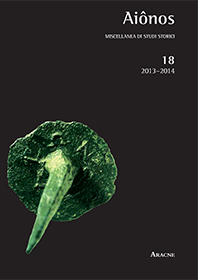Estratto da
AIôNOS
Miscellanea di Studi Storici (2013–2014)
“Rivindiche”. Violenza sociale e mobilitazione politica in Calabria nel 1848
AIôNOS
Miscellanea di Studi Storici (2013–2014)
“Rivindiche”. Violenza sociale e mobilitazione politica in Calabria nel 1848

This paper deals with peasants’ occupations of lands, forests and mines in Calabria during the Revolution of 1848. These mass actions of social violence were referred to as “revindiche” and were intended to achieve the occupation, both physical and symbolic, of “goods” perceived as “usurped”. Analyzing rituality, political–religious symbolism and organization of these actions, this research shows that the popular movement of “revindica” was not an isolated phenomenon of jacquerie but part of the political developments of the revolution in the periphery. On the one hand, I claim, it was rooted in long–lasting controversies around the civic uses of communal lands that led to the formation of a collective and municipal based consciousness of public goods and the Common Good. On the other hand, the political mobilization of the rural peoples was, at that historical moment, organized and directed by“popular” and democratic circles led by radical political leaders that can be called with the term coined for Provence by the historian Maurice Agulhon: the “red bourgeoisie”. An analysis of such revolutionary alliance between rural populations and the “red bourgeoisie” can help to explain the radicalization of the peripheries of the European Mediterranean, such as Calabria and the Var, ready in 1848 and in 1851 to offer their support to republican and anti–monarchist insurrections against Ferdinand II Bourbon and Louis Napoleon Bonaparte.Parole chiave: radicalismo, rivolte rurali, usi civici, beni comuni, Bene Comune,Calabria, 1848Keywords: radicalism, rural revolts, civic uses, commons, Common Good, Calabria, 1848
| pagine: | 135-174 |
| DOI: | 10.4399/97888548882587 |
| data pubblicazione: | Dicembre 2015 |
| editore: | Aracne |








